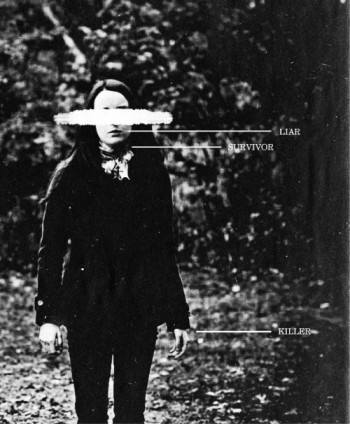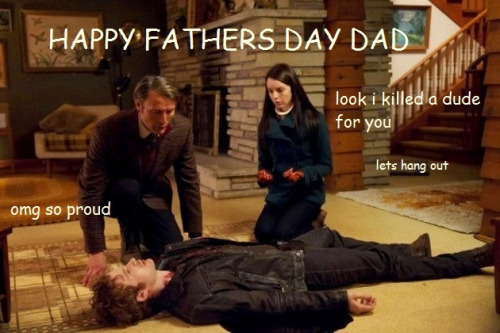“Long Live Abigail Hobbs”: The Significance of Hannibal‘s Deviant “Daughter”
Post by Allison McCracken, DePaul University
[This is the final of a three-part series highlighting some of Hannibal‘s unique contributions to the television world, in commemoration of its final week on NBC. Black-and-white art by travelersfarfromhome. See Part 1 here, Part 2 here, and please note that this post contains spoilers through episode 3.2]
I became interested in watching Hannibal after I attended a panel about the show at a fan convention geared towards young women. This panel represented the active fans that the show’s Tumblr had helped cultivate, the “Fannibals.” I was struck by how much they spoke of their love for the show’s female characters. Generally in programs with two male leads—especially shows with horror elements—female characters are peripheral and don’t stay alive for very long. Hannibal is ultimately also limited in this way—an issue that Hannibal actor Hettienne Park (Beverly Katz) has eloquently addressed—yet Hannibal still has many more recurring, sharply drawn female characters than do other shows of its genre (Supernatural, True Detective). Showrunner Bryan Fuller changed several key male characters from the source material (Alana Bloom, Freddie Lounds) to female characters and created a number of new female characters (including women of color). These decisions opened up many new points of identification for female viewers. As a result, Hannibal has expanded the cultural work of this gothic horror text and the resonance it has for contemporary female fans.
Here, I am focusing specifically on Hannibal‘s portrayal of teenage killer/survivor Abigail Hobbs because she has been so prominent in the fandom, particularly on Tumblr, a space where fandom and feminism frequently intersect. On Tumblr, fans’ larger cultural critiques focus on such topics as women’s devaluation through feminization and sexualization, particularly in the media; poor institutional and familial responses to women’s trauma; and the pathologizing of female deviance. For many of these viewers, Abigail Hobbs provides not only a point of convergence for these concerns but, in many ways, validates them.
Hannibal‘s grounding in gothic horror defines the kind of critical work it can do. As a genre, horror foregrounds deviant characters and thus puts the normative into relief. The subgenre of gothic horror has always had particular appeal for women, in part because its romanticism privileges emotional intensity over rationality, which in turn has the potential to de-naturalize the “rational” institutions and oppressive structures of patriarchy. The “monster” character central to the gothic often appears, initially, as an attractive male, a symbol of professional expertise, generous paternalism, and romantic sincerity, but these qualities are revealed to be deceptive and threatening to women.
Fuller invokes these gothic horror tropes in Hannibal in ways that particularly serve today’s female and feminist fans. For example, Fuller pledged not to show sexual violence toward any female characters on Hannibal (another change from the source material), a move that has impressed his female audience and has given the show’s feminism real weight. This is not to say that the show does not depict eroticized violence. Like a vampire, Hannibal exerts a sensuous appeal and he derives pleasure from bloodletting and feeding. Significantly, as in vampire narratives, the site of Abigail Hobbs’ penetration is displaced onto her throat. This permits the show to allude to sexual violence without engaging in representations of rape.
Abigail Hobbs is a central figure of Hannibal‘s first season, and her presence haunts the text (literally and symbolically) thereafter. Abigail is initially introduced as a traumatized girl whose throat, in the pilot, is slashed by her serial-killer father (an attack from which she recovers). She brings out paternal feelings in Hannibal and Will, yet as the season progresses, she kills a man (impulsively, but in self-defense) and reveals that she served as a procurer for her father, luring adolescent female victims to him. She is smart, socially alienated, suspicious, reserved, and plagued with worry that her father’s hunter/killer training (whether organically or through socialization) has made her a monster too. Abigail’s social deviance as, at once, a trauma survivor and a killer, has made her a source of identification and love for many fans, who have devoted Tumblr sites to her, written fanfic about her, and created art featuring her. Abigail’s fears are vividly conveyed in this fanvid by kiki_miserychic [warning: graphic violence]
Reading Hannibal through Abigail’s point of view, we see how men in the text constantly misunderstand, abuse, patronize, deceive, and undermine her. With the exception of Hannibal, men do not see her as a complicated person. Will views her only as either a childlike victim or, later, as a pathological killer; she resists his paternalism very directly: “Just because you killed my father, doesn’t mean you can become him.” Likewise, we see how patriarchal structures (the justice system, the family) only serve to further traumatize her. She lies to the FBI and the police because she knows the criminal justice system would not put her crimes in context, and we know that too; the recent decision to try two 13-year-old girls as adults for attempted murder—the Slender Man case—points to the inability of the justice system to countenance violent girls. Hannibal also highlights Abigail’s persistent attempts at self-definition and agency, including an attempt to ensure her financial independence from Will and Hannibal by selling her story to journalist Freddie Lounds. Fans indicate their approval of these moments by reblogging “Abigail’s sassy face” on Tumblr.
 Ultimately, however, Abigail cleaves to Hannibal because he does see her complexity and value (the ability to truly “see” another person is a significant theme in the series) and because he puts himself outside of the law, openly rejecting the social norms and boundaries that oppress her. Both Hannibal and the gothic horror genre provide fantasies of escape from social oppression, and a lot of the Fannibals’ dark humor comes from their pleasure in fantasies of deviance and subversion. For example, Abigail’s role as the daughter in the “murder family” with Will and Hannibal is the subject of much fan creative production.
Ultimately, however, Abigail cleaves to Hannibal because he does see her complexity and value (the ability to truly “see” another person is a significant theme in the series) and because he puts himself outside of the law, openly rejecting the social norms and boundaries that oppress her. Both Hannibal and the gothic horror genre provide fantasies of escape from social oppression, and a lot of the Fannibals’ dark humor comes from their pleasure in fantasies of deviance and subversion. For example, Abigail’s role as the daughter in the “murder family” with Will and Hannibal is the subject of much fan creative production.
At the same time, Hannibal provides a cautionary tale that taps directly into young women’s concerns about daily survival under patriarchy. In a contemporary context, Hannibal is the textbook abusive parent or lover who literally traps her, and Abigail’s abuse, captivity, and eventual death at his hands is the central tragedy of the series. But it’s because Hannibal allows viewers to see her struggle that her death has the significance and resonance that it does, haunting both characters and viewers.







